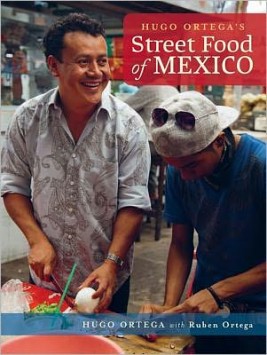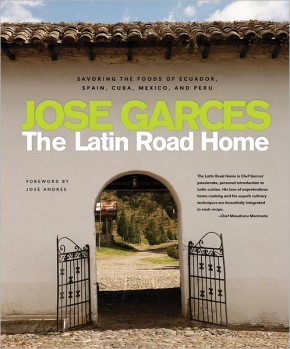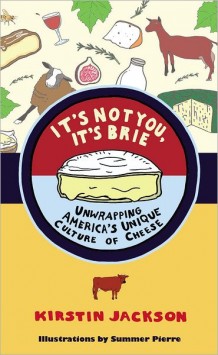HartwoodBright, Wild Flavors from the Edge of the Yucatán
With Christine Muhlke and Oliver Strand

The best things happen when people pursue their dreams. Consider the story of Eric Werner and Mya Henry, an intrepid young couple who gave up their restaurant jobs in New York City to start anew in the one-road town of Tulum, Mexico. Here they built Hartwood, one of the most exciting and inspiring restaurants in the world. Mya Henry took on the role of general manager, seeing to the overall operations and tending to the guests, while Eric Werner went to work magic in the kitchen.
The food served at Hartwood is “addictive,” says Noma chef René Redzepi, adding, “It’s the reason people line up for hours every single day to eat there, even though their vacation time is precious.”
Werner’s passion for dazzling flavors and natural ingredients is expertly translated into recipes anyone can cook at home. Every dish has a balance of sweet and spicy, fresh and dried, oil and acid, without relying heavily on wheat and dairy. The flavoring elements are simple—honeys, salts, fresh and dried herbs, fresh and dried chiles, onions, garlic—but by using the same ingredients in different forms, Werner layers flavors to bring forth maximum deliciousness. The recipes are beautifully photographed and interspersed with inspiring, gorgeously illustrated essays about this setting and story, making Hartwood an exhilarating experience from beginning to end.
Christine Muhlke is an editor at The New York Times. She has written for Vogue, Vanity Fair, Food & Wine, and other publications.
Grouper with White Bean Salad and Cilantro Crema
Lime and Honey Vinaigrette
Roasted Garlic Oil and Roasted Garlic
Grapefruit, Mezcal, and Burnt Honey Cake![]()
Grouper with White Bean Salad and Cilantro Crema
Serves 4
Grouper is a meaty, buttery fish, and when you roast it in the oven, all the juiciness comes through—it’s like the steak of the sea. If you get a nice fat fillet, you can cook it a little longer and it won’t dry out on you; it’ll just get better, which is useful when you want to get extra-crispy skin. Grouper is forgiving.
The flesh is a surprisingly good match for beans. In this recipe, the white bean salad gets a little heat and smoke from roasted poblanos. It’s tossed with the lime and honey vinaigrette we use in many of our salads, then topped with a cilantro crema. The fresh, herbal flavors of the cilantro are offset by the earthy sweetness of the roasted garlic we get when making roasted garlic oil. We use dried beans, which you will need to soak overnight. You can use 3 cups canned white beans if you want to take a shortcut, but dried beans taste better.
White Bean Salad
1½ cups dried navy beans or other creamy white beans, soaked overnight in water to cover
1 onion, cut in half
1 carrot, peeled and cut in half
4 oregano stems
2 tablespoons kosher salt, or to taste
5 poblano peppers
Olive oil
4 cups arugula
½ cup cilantro leaves
½ cup Lime and Honey Vinaigrette (recipe follows)
4 grouper fillets (6 to 8 ounces each), skin on
Olive oil
Kosher salt and freshly ground black pepper
1 red onion, thinly sliced
8 tablespoons (1 stick) unsalted butter, cubed
1 jalapeño, very thinly sliced
Cilantro Crema
1 cup sour cream
¼ cup olive oil
1½ teaspoons mashed Roasted Garlic (recipe follows)
1 teaspoon kosher salt
1 teaspoon freshly ground black pepper
1 cup cilantro leaves (some tender stems are fine)
2 limes, halved
1. Preheat the oven to 400°F.
2. Prepare the beans and poblanos for the salad: Drain the beans and put in a large saucepan, along with the onion, carrot, and oregano. Add water to cover by 2 inches, then add the salt and boil gently over medium heat for 30 to 45 minutes, until the beans are soft. Drain the beans, discarding the onion, carrot, and oregano. Transfer to a bowl and let cool.
3. While the beans are cooking, coat the poblanos with olive oil, put on a small baking sheet, and roast for 20 minutes. Flip the peppers and roast for 20 minutes longer, or until charred all over. Let the peppers cool, then remove the seeds and skin. Cut into ½-inch-wide strips and fold into the white beans. Set aside.
4. Reduce the oven temperature to 350°F.
5. Coat the grouper fillets with olive oil and season with salt and pepper. Oil the grill grate and grill the fish skin side down for about 1 minute to get nice grill marks. Turn 45 degrees and cook for 1 minute longer. Flip and repeat.
6. Put the red onion and butter in a large cast-iron skillet. Transfer the fish, skin side up, to the skillet and drizzle olive oil over the skin. Roast in the oven until just cooked through, about 10 minutes.
7. Meanwhile, add the arugula and cilantro to the white beans and stir gently to combine, being careful not to mash the beans. Add the vinaigrette and stir to incorporate.
8. Make the crema: Combine the sour cream, olive oil, roasted garlic, salt, and pepper in a blender and puree until smooth, about 30 seconds. Add the cilantro in two or three batches, pulsing for about 10 seconds after each addition. Transfer to a bowl, cover, and refrigerate until ready to serve.
9. Spoon the salad onto individual plates and drizzle with the cilantro crema. Top with the grouper and red onions. There will be some brown butter left in the skillet—pour it over everything. Garnish with the jalapeño slices (about 2 per fillet) and limes.
Lime and Honey Vinaigrette
Makes about 1 cup
There are so many limes in Mexico. It’s an ingredient that you use for everything: drinks, soups, meat, desserts. So this vinaigrette has lots of applications. You can use it as a marinade, as a way to get proteins started before you put them on the grill or in the oven, or as a finishing touch. It breaks through that smoke and char. And, of course, it’s great on salads.
¼ cup fresh lime juice (from 2 to 3 limes), or to taste
¾ cup olive oil
2 tablespoons honey, or to taste
1 teaspoon kosher salt, or to taste
1. Whisk all the ingredients in a small bowl until emulsified, then taste—everything should be in balance: the acid of the lime, the sweetness of the honey, the salinity of the salt. If anything is too faint, add more of whatever is missing. The vinaigrette will keep for up to a week in the refrigerator; whisk again before serving to re-emulsify it.
Roasted Garlic Oil and Roasted Garlic
Makes about 1 liter (about 4 cups) oil, plus roasted garlic
This recipe gives you two foundations of flavor. The oil, which tastes sweet and buttery, is one of the key elements in our grilled octopus. But the roasted garlic is integral to so much of what we cook that we would make the oil just to get the cloves. We use the oil in dressings and sauces and to flavor the leafy greens we serve with meat dishes.
6 whole heads garlic
3 thyme sprigs
3 oregano sprigs
One 1-liter bottle olive oil
1. Preheat the oven to 350°F.
2. Slice off the top ½ inch of each garlic head so that most of the cloves are exposed. Put the garlic in a deep sturdy 10-inch pan with the herbs and add enough olive oil so that the heads are just above the surface. Cover with parchment paper, then tightly cover the pan with foil. Roast for 45 minutes, or until the garlic is soft—check by piercing a head with a paring knife. Remove the parchment and foil and roast for 5 more minutes to brown the garlic a bit. Let cool.
3. Strain the oil into a 1-liter measuring cup; set the garlic aside. Return the oil to its original bottle (simply pour though a funnel set into the neck of the bottle). Cover the oil and keep in a cool, dark place (the oil will last longer if you refrigerate it; just be sure to take it out about an hour before cooking to liquefy).
4. Put the garlic heads in a bowl to collect the oil. Then separate the cloves and squeeze the pulp into a pint jar. Discard the papery skin and herbs. Strain the oil that collected in the bowl and use to cover the garlic; add more of the garlic oil if necessary to cover it. Cover and refrigerate; the roasted garlic will keep for up to 2 weeks.![]()
Grapefruit, Mezcal, and Burnt Honey Cake
Serves 8 to 10
This cake is smoky and moist. The grapefruit holds the smokiness of the mezcal so that the flavor permeates the entire cake without overdoing it—you taste a little bit of everything in each bite, all the flavors in balance.
Cake
3½ cups all-purpose flour
¼ cup ground cinnamon
1 teaspoon baking soda
½ teaspoon baking powder
Pinch of salt
½ pound (2 sticks) unsalted butter, cubed, softened
1 cup sugar
3 large eggs
1 tablespoon vanilla extract
1½ cups plain whole-milk yogurt
¼ cup sweetened condensed milk
1 cup dark honey
2 grapefruit, suprêmed (see Note; zest the grapefruit first for the caramel and then squeeze the juice from the membranes as well)
Caramel
1 cup water
½ cup sugar
¼ cup grapefruit juice (reserved from the grapefruits you suprêmed)
2 tablespoons mezcal
¼ cup dark honey
1 tablespoon grated grapefruit zest (from the grapefruits you suprêmed)
2 tablespoons unsalted butter
Confectioner’s sugar for dusting (optional)
1. Preheat the oven to 350°F. Butter a 9-inch round cake pan; line with baking parchment and butter the parchment.
2. Whisk together the flour, cinnamon, baking soda, baking powder, and salt in a medium bowl.
3. Using a handheld electric mixer, cream the butter and sugar in a large bowl until light and fluffy. Add the eggs one at a time, mixing well after addition, then add the vanilla and mix to combine. Add the yogurt, sweetened condensed milk, and ¾ cup of the honey and mix to combine. Mix the dry ingredients into the wet ingredients, being careful not to overmix.
4. Arrange the grapefruit suprêmes in concentric rings in the bottom of the cake pan. Pour the remaining ¼ cup honey over the grapefruit. Pour the batter into the pan. Bake for 45 minutes, or until a cake tester inserted into the center comes out clean. Transfer the pan to a rack and let cool.
5. Make the caramel: Combine the water and sugar in a medium saucepan, bring to a simmer, and simmer until the sugar melts and the caramel turns a dark amber color. (Be careful at the end—it can burn quickly.) Add the grapefruit juice (the caramel will bubble up) and swirl to incorporate, then add the mezcal and continue swirling until the caramel returns to a dark amber. Add the honey, grapefruit zest, and butter and swirl to incorporate, then take off the heat.
6. At Hartwood, we brûlée the top of the cake by putting the pan on the grill, grapefruit side down, for 3 to 4 minutes, so that the grapefruit and honey turn golden brown and crisp up. You probably won’t do that, but if you want the same effect, invert the cake onto a rack, peel off the parchment, and brown the top with a blowtorch. Or set it under a preheated broiler for 1 to 2 minutes, until bubbly and browned.
7. If you have not already done so, invert the cake onto a cooling rack and remove the paper. Transfer the cake to a serving plate and pour over the warm caramel. Sprinkle with confectioners’ sugar, if desired.
Note:
How to Suprême Citrus
This is a classic restaurant technique for trimming off all the peel and bitter pith and separating the sections from the membranes so that all that is left is fruit. The secret is to use a super-sharp knife, which will cut with little effort; if the knife is dull, you’ll need to apply some pressure, and that’s where you get into trouble.
First, slice off the top and bottom of the fruit so that you see two tiny circles of flesh. Then, slice off the skin, pith, and outer membrane, following the curvature of the fruit. Trim off any white patches left after you cut off all the peel.
Now you can either stop here and just cut the fruit into ½-inch slices, or you can follow this standard chef’s technique. Holding the fruit in one hand and the knife in the other, working over a small bowl, slice as close as possible to the membranes that separate the sections: Slice along one, then the other, and flick the loosened section into the bowl. When the entire fruit has been sectioned, squeeze the juice from the remaining membranes with your hand and reserve for another use.
Excerpted from Hartwood by Eric Werner and Mya Henry with Christine Mulke and Oliver Strand (Artisan Books). Copyright © 2015. Photographs by Gentl & Hyers.











Leave a Reply